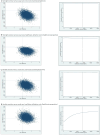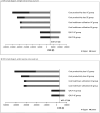Cost-effectiveness of strength exercise or aerobic exercise compared with usual care for patients with knee osteoarthritis: secondary results from a multiarm randomised controlled trial in Norway
- PMID: 38803266
- PMCID: PMC11328638
- DOI: 10.1136/bmjopen-2023-079704
Cost-effectiveness of strength exercise or aerobic exercise compared with usual care for patients with knee osteoarthritis: secondary results from a multiarm randomised controlled trial in Norway
Abstract
Objectives: To evaluate the 1-year cost-effectiveness of strength exercise or aerobic exercise compared with usual care for patients with symptomatic knee osteoarthritis (OA), from a societal and healthcare perspective.
Design: Cost-effectiveness analysis embedded in a three-arm randomised controlled trial.
Participants and setting: A total of 161 people with symptomatic knee OA seeking Norwegian primary or secondary care were included in the analyses.
Interventions: Participants were randomised to either 12 weeks of strength exercise (n=54), 12 weeks of aerobic exercise (n=53) or usual care (n=54).
Outcome measures: Quality-adjusted life-years (QALYs) estimated by the EuroQol-5 Dimensions-5 Levels, and costs related to healthcare utilisation and productivity loss estimated in euros (€), aggregated for 1 year of follow-up. Cost-effectiveness was expressed with mean incremental cost-effectiveness ratios (ICERs). Bootstrapping was used to estimate ICER uncertainty.
Results: From a 1-year societal perspective, the mean cost per patient was €7954, €8101 and €17 398 in the strength exercise, aerobic exercise and usual care group, respectively. From a 1-year healthcare perspective, the mean cost per patient was €848, €2003 and €1654 in the strength exercise, aerobic exercise and usual care group, respectively. Mean differences in costs significantly favoured strength exercise and aerobic exercise from a 1-year societal perspective and strength exercise from a 1-year healthcare perspective. There were no significant differences in mean QALYs between groups. From a 1-year societal perspective, at a willingness-to-pay threshold of €27 500, the probability of strength exercise or aerobic exercise being cost-effective was ≥98%. From a 1-year healthcare perspective, the probability of strength exercise or aerobic exercise being cost-effective was ≥97% and ≥76%, respectively.
Conclusion: From a 1-year societal and healthcare perspective, a 12-week strength exercise or aerobic exercise programme is cost-effective compared with usual care in patients with symptomatic knee OA.
Trial registration number: NCT01682980.
Keywords: health economics; physical therapy modalities; primary health care.
© Author(s) (or their employer(s)) 2024. Re-use permitted under CC BY. Published by BMJ.
Conflict of interest statement
Competing interests: None declared.
Figures


References
Publication types
MeSH terms
Associated data
LinkOut - more resources
Full Text Sources
Medical
